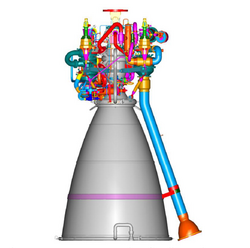 A computer model of CE-20 | |
| Country of origin | India |
|---|---|
| First flight | June 5, 2017 |
| Designer | LPSC, ISRO |
| Manufacturer | Hindustan Aeronautics Limited[1] |
| Application | Upper stage booster |
| Status | Active |
| Liquid-fuel engine | |
| Propellant | LOX / LH2 |
| Mixture ratio | 5.05 |
| Cycle | Gas Generator |
| Configuration | |
| Chamber | 1 |
| Nozzle ratio | 100 |
| Performance | |
| Thrust, vacuum | 186.36 kN (41,900 lbf) |
| Throttle range | 180–220 kN (40,000–49,000 lbf) |
| Chamber pressure | 6 MPa (870 psi) |
| Specific impulse, vacuum | 442 seconds (4.33 km/s) |
| Burn time | 640-800 seconds |
| Dimensions | |
| Dry weight | 588 kg (1,296 lb) |
| Used in | |
| Upper stage of LVM3 | |
| References | |
| References | [2][3][4] |
The CE-20 is a cryogenic rocket engine developed by the Liquid Propulsion Systems Centre (LPSC), a subsidiary of the Indian Space Research Organisation (ISRO). It has been developed to power the upper stage of the LVM3.[5] It is the first Indian cryogenic engine to feature a gas-generator cycle.[6] The high thrust cryogenic engine is the most powerful upper stage cryogenic engine in operational service.[7]


